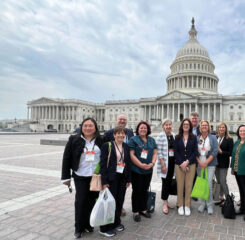Mandate Minute: Week 12
This Week’s Highlights:
Volume Twenty: Air Date 2.7.22. “Why People Aren’t Boostering”
An article in the New York Times this morning – which pulled data from the recent Kaiser Family Foundation booster demographics poll – analyzed why the U.S. is lagging so far behind most of Europe, Australia and Canada in getting the population that is eligible for boosters boosted. This is one reason why the U.S. has seen more COVID related deaths over the past two months for those same countries.
Let’s take a look at what they found. First, unlike those who choose to remain unvaccinated, the Kaiser poll found that there is a very even split between ages, races, and political party affiliations among those who have or have not yet been boosted. In total, 70% of all eligible adults have been boosted, and 86% among those 65 or better. So what explains the delay?
The article offers two explanations:
· “First, medical care in the U.S. is notoriously fragmented.” We don’t have a centralized record system, like Taiwan, nor a universal insurance system, as in Canada, to remind people to get another shot. Many Americans also do not have a primary care physician. So, preventative care – like a booster – tends to fall between the cracks.
· The second problem is that some health officials, as well as some experts, struggle to communicate effectively. They emphasize minor details that are unimportant to the vaccination effort and yet confuse the very people they hope will get boosted.
An illustration that the authors offered helps demonstrate: “imagine if a group of engineers surrounded firefighters outside a burning building and started questioning whether they were using the most powerful hoses on the market. The questions might be reasonable in another setting — and pointless if not damaging during a blaze.”
These, the authors suggest, coupled with slow moves on the part of regulators to approve and promote the shots and rapid tests, have led to a robust sense of public skepticism that interferes with a sense of urgency to get the booster shot.
So – as always – booster reminders, incentives, requirements, and reliable information about why people should get boosted remain the best ways to motivate them to do so.
Meanwhile, Illinois has just joined the small but growing list of states that are requiring booster shots for healthcare workers.
Volume Twenty-One: Air Date 2.9.22. “Fear of Needles, Revisited”
This week we will revisit a topic we haven’t discussed for a year and that is the fear of needles which may make many people reluctant to get the COVID-19 vaccine.
About 10% of Americans are highly anxious about needles, and 3% to 4.5% experience what is known as blood-injection-injury phobia at some point in their lives. “When you look at the U.S. population,” Chernoff says, “that’s millions of people.” Needle-related anxiety may sway people from getting the COVID-19 vaccine and they are often reluctant to admit to this from feelings of shame.
However, several strategies may help to overcome needle-related fears:
Look away
There’s no reason to watch what’s happening.
Use relaxation
Deep-breathing techniques, visualization or other relaxation strategies may help.
Find a role model
If possible, schedule your vaccination with a trusted friend who doesn’t fear needles. Ask your friend to go first and watch their reaction.
Numb the site
If the pain associated with injections causes anxiety, ice or over-the-counter lidocaine cream may dull the pain and ease your mind.
Expose yourself to needles
Deliberately exposing yourself to your fears—in this case, needles—can make them less intimidating. Exposure therapy, also known as systematic desensitization, might begin with viewing pictures or videos of needles and progress to watching someone else get a shot.
Reframe your thoughts
Instead of focusing on momentary discomfort, recognize that injection pain disappears quickly but the positive effects last much longer.
Tense your muscles
If you faint around needles, your blood pressure and heart rate may rise, then fall suddenly from the sight of a syringe, causing lightheadedness. A research-proven technique called applied tension may help. “Patients who become faint at the sight of needles can learn to tense their muscles, including the abdominal, leg and arm muscles, because that raises their blood pressure, It actually counteracts that sense of wanting to faint.”
More information can be found in the link above. It would be good to make sure employees are aware of therapists that may be able to help them – for example, with your Employee Assistance Program or local community mental health center.

Most Recommended
February 29, 2024
Say Yes to Lobby Day!
April 05, 2024
Cyberattack Updates: Change Healthcare Payment Platform
March 27, 2024
 Colleagues on the Move, March 27, 2024
Colleagues on the Move, March 27, 2024
April 12, 2024
Improving Medicare Advantage
Recently Added
April 19, 2024
In the Words of Advocates: Lobby Day Stories from Members
April 17, 2024



